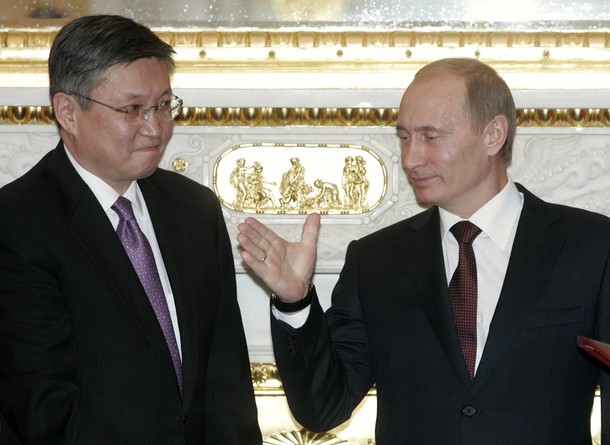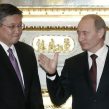
Russia Promotes Joint Ventures with Mongolia
Publication: Eurasia Daily Monitor Volume: 6 Issue: 101
By:

The Kremlin has reiterated its pledges to implement sizable infrastructure development projects in Mongolia in an attempt to boost bilateral economic ties. On ?May 13, the Russian Prime Minister Vladimir Putin visited Mongolia, urging the country to create new major joint ventures and develop agricultural cooperation. He also stated that both countries will shortly conclude an agreement on joint uranium mining (Interfax, ITAR-TASS, RIA Novosti, May 13).
In response, Prime Minister Sanjaa Bayar said that Mongolia also aimed to develop nuclear cooperation with Russia. He suggested that Russian agricultural loans to Mongolia might be extended on similar terms offered by international financial organizations. Bayar proposed speeding up the creation of a bilateral joint venture to mine uranium in Mongolia. He also said that the Russian Chief of the General Staff Army-General Nikolai Makarov, had recently traveled to the country to discuss military ties, including the modernization of the Mongolian army (Interfax, ITAR-TASS, RIA Novosti, May 13).
During Putin’s visit, five agreements were signed on nuclear, transport and agricultural cooperation. The Russian national airline Aeroflot and the Mongolian MIAT inked an agreement on flights between the two capitals (Interfax, ITAR-TASS, RIA Novosti, May 13).
The most significant deal, however, was clinched by the Russian Railroad (RZD) company. RZD agreed to form a joint venture with Erdenes MGL and the Mongolyn Tomor Zam to upgrade Mongolian railroads and develop the Tavan-Tolgoi coal deposit as well as the Oyu-Tolgoi copper and gold mines. The Mongolian side will contribute mining licenses, while RZD pledged to build railroad links to both deposits. On May 13 the RZD CEO Vladimir Yakunin announced that the company had also secured a 50 percent stake in the Ulaanbaatar Railroad. He said that the RZD-led joint project to develop the Mongolian coal and copper mining infrastructure might reach a value of $7 billion (Interfax, ITAR-TASS, RIA Novosti, May 13).
The Mongolian government has long promised to support Russian investment in new projects to develop the country’s mineral deposits, including Tavan Tolgoi in southern Mongolia. Major Russian companies have expressed an interest in Mongolia’s Tavan Tolgoi coal deposit in southern Gobi region, which has estimated reserves of 5-6 billion tons. The Oyu Tolgoi field is believed to contain up to 30 million tons of copper and about 32 million ounces of gold.
Russian officials insist that these projects are economically viable. On May 13 the Russian Energy Minister Sergei Shmatko said that Moscow might also consider building power plants in Mongolia, in order to export electricity to China. These plants could be powered using Mongolian coal reserves, he said (Interfax, May 13).
Nonetheless, the Russian media questioned the economic viability of such joint ventures. The Kommersant daily commented on May 14 that Tavan Tolgoi remained a difficult project with unclear prospects. Mongolian coal is due to be mined thousands of kilometers away from the nearest seaports, thus rendering it uncompetitive (Kommersant, May 14).
Since earlier this year, the Kremlin has offered Mongolia some measured economic incentives. On March 17 during a meeting with Sanjaa Bayar in Moscow, Putin pledged to grant Mongolia a $300 million loan to import Russian goods to develop Mongolian agriculture. However, Russian financial institutions have since proved slow to disburse the promised loan.
Meanwhile, the Mongolian offer to form closer bilateral relations received a non-committal response from Russian officials. At a meeting with Putin on May 13, the Mongolian President Nambaryn Enkhbayar suggested improving cross-border exchanges, and allowing visa-free travel across the border. In response, Putin appeared unenthusiastic, saying only that these initiatives required further examination (Interfax, May 13).
Russia remains Mongolia’s major foreign trade partner. In 2008, bilateral trade reached $1.3 billion, including $1 billion in Russian exports to Mongolia (Interfax, May 13). In 2007, their trade turnover amounted to around $670 million -or 30 percent up year-on-year, according to official Russian customs statistics.
When Putin traveled to Mongolia in 2000, both sides agreed to boost economic ties. Since the Soviet collapse in 1991, bilateral economic relations were overshadowed by Mongolia’s Soviet-era debt to Russia. In December 2003, the Russian government decided to write off almost the entire debt, estimated at $11 billion. However, the debt write-off has proved slow in stimulating investment. In the Soviet era, the Mongolian economy heavily relied on massive loans and aid. More than 700 projects were developed, including over 1,000 kilometers in road construction. The Erdenet copper mining company, Ulaanbaatar Railroad and the MongolRosTsvetmet metal firm are currently involved in three major joint ventures with Russia -accounting for as much as 20 percent of Mongolian GDP. Moreover, Russia holds major stakes in Erdenet, the Ulaanbaatar Railroad and in MongolRosTsvetmet.
Moreover, Moscow has expressed interested in developing Mongolian uranium deposits. In March, the Russian nuclear agency Rosatom and the Mongolian Nuclear Energy Agency signed an agreement on bilateral cooperation. Rosatom wants to enter a joint venture to develop uranium deposits in Mongolia. Those deposits within northeastern Mongolia, including Dornod and the eastern Gobi fields, are close to Russia’s largest uranium deposit in Priargunsky. Mongolian experts have estimated the country’s uranium deposits at 60,000 tons, while Rosatom believes the figure might be up to 100,000 tons.
Officials in Moscow and Ulaanbaatar have long pledged to revive their bilateral economic partnership. However, the ambitious scale of joint projects has proven slow to implement.




